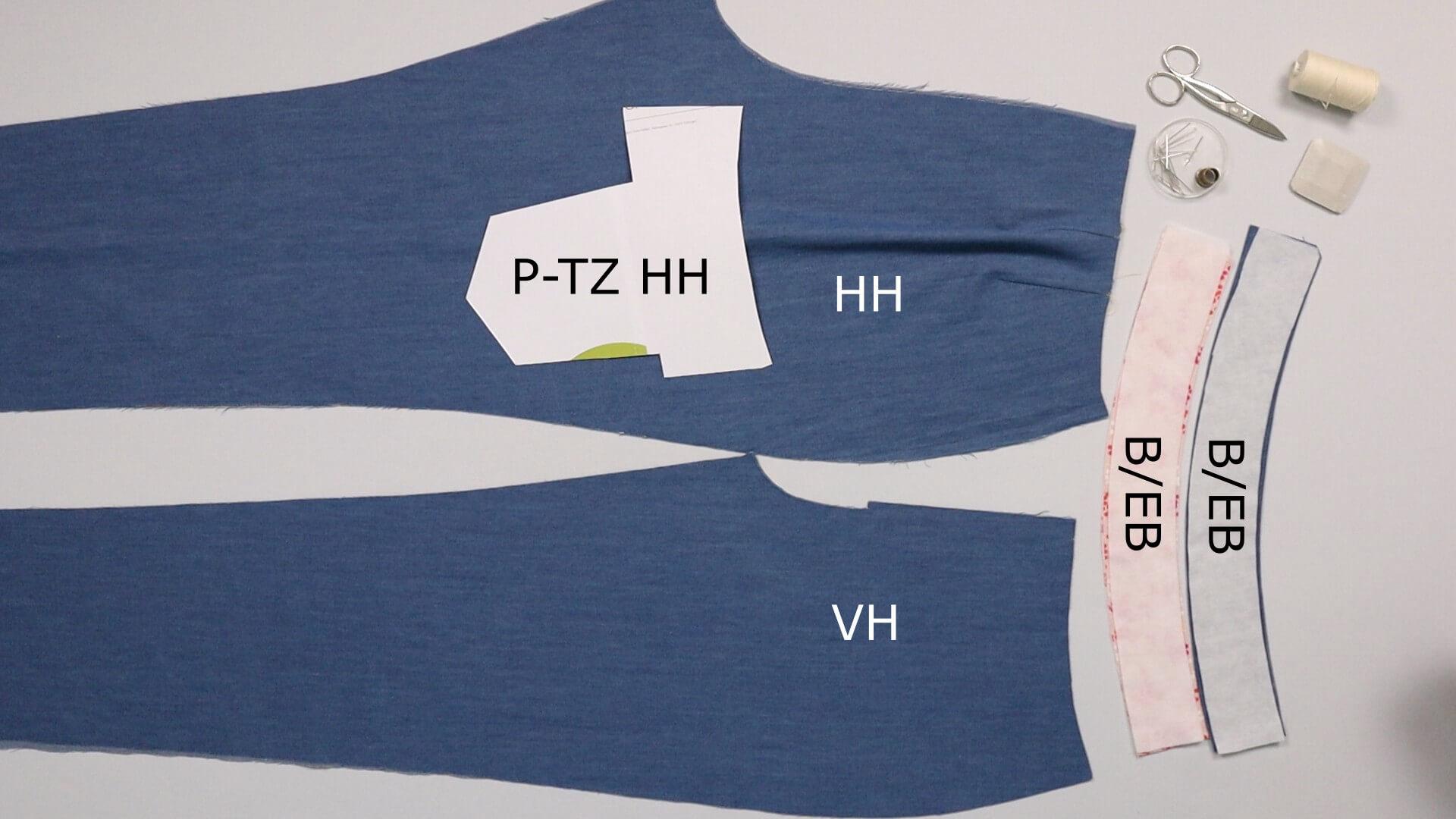Preparing trousers with waistband for fitting #F02
In the following instruction, I explain step by step via video and illustrated text instructions how I prepare a pair of trousers for fitting.
Even with made-to-measure trousers, it is highly recommended that you try them on before finishing them. f you have garments tailored professionally, customers always go in for a final fitting before the garment is finished. For this reason, our patterns include wider seam allowances which can be used to adjust if necessary. To get a realistic impression of how the finished trousers will fit, it is important to sew on the waistband to try them on. This is especially necessary for the shaped waistband, as the circumference at the bottom edge is much larger than at the top edge. Since the trousers will be taken apart again after fitting, I will sew the pieces together with a long machine stitch and barely secure them. However, you can also baste the seams by hand, which is particularly recommended for delicate fabrics. Enjoy preparing your trousers for fitting!
Video instructions:
The video instructions are currently only available in German. Via settings you can have YouTube display the subtitles in your language of choice.
Pattern pieces made from main fabric:
- back pieces – 1 pair; the darts are already incorporated.
- front pieces (VH) – 1 pair; the area for the pocket is still attached for the fitting; after the fitting you can cut it off at the marked line.
- waistband (B) – 2x
Pattern pieces from interfacing:
- waistband (EB) – 2 pairs
Paper pattern pieces:
- back (HH)
- front (VH)
- waistband (B)
- if necessary, the template for the pocket position (P-TZ HH)
Tools and aids:
- pins or clips
- scissors
- chalk or fabric marker
- basting thread and hand sewing needle if necessary
At this point, I am anticipating the work step for the waistband processing. I will replace the inner waistband and make it from the same material as my pocket bags, instead of using the main fabric. This is a nice detail and you can better distinguish between the inside and outside of the waistband in the instructions. With a pattern that is intended for elastic material, make sure that the material on the inside has similar stretch properties to the main fabric. If you have chosen a pattern that is designed for non-stretch fabrc, but you are using a stretchy fabric, fix the waistband so that it does not stretch out and the trousers will not slip down as a result.
2. Close the seat seam
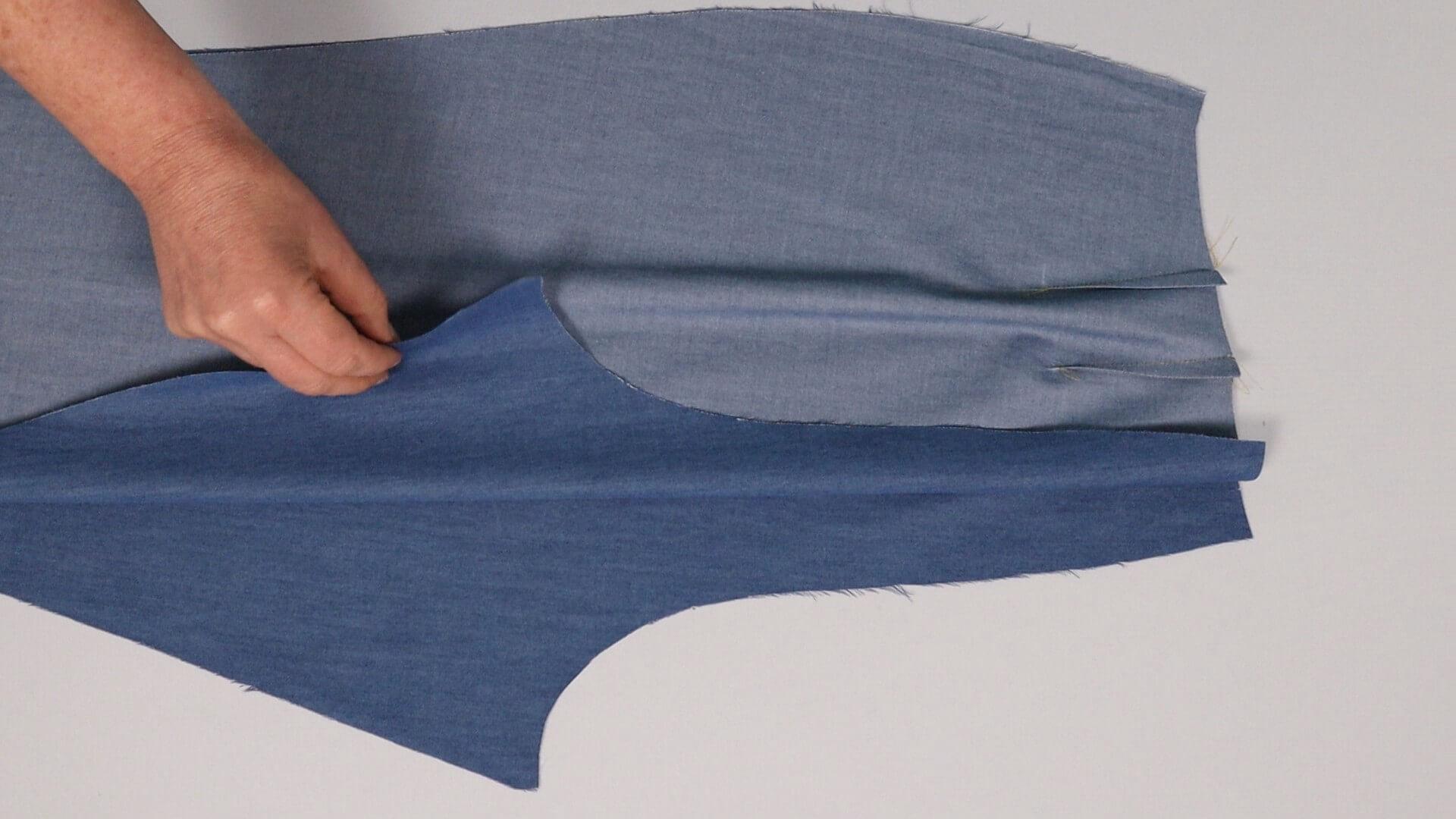
First, the seat seam is joined. Place the back trouser parts on top of each other, right sides facing.
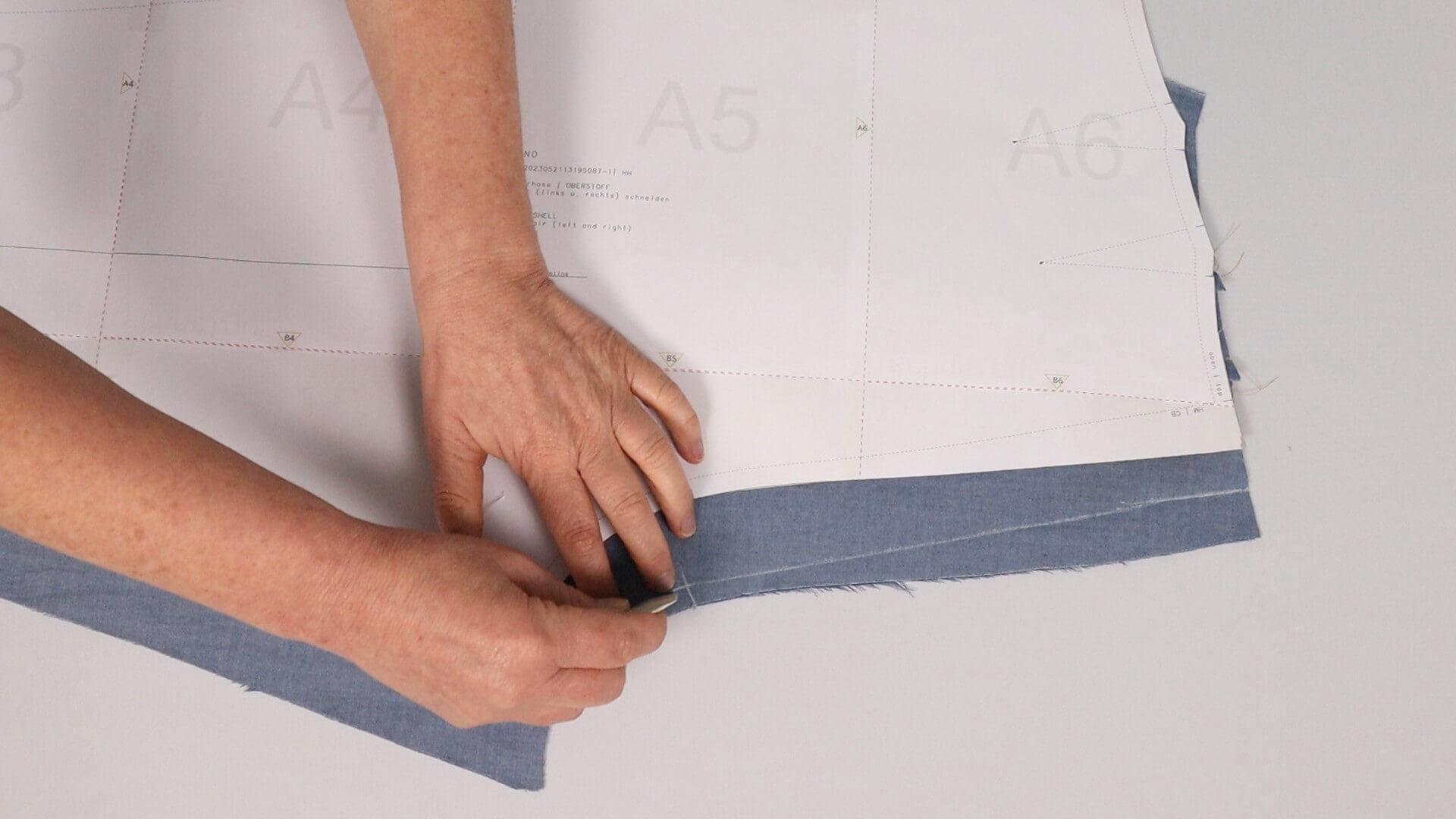
I use the pattern to transfer the finished seam course. The seam allowance runs parallel in the lower area up to the notch. It becomes wider from the notches up to the waistband. Transfer the line to the notch at the center back of the waistband edge.
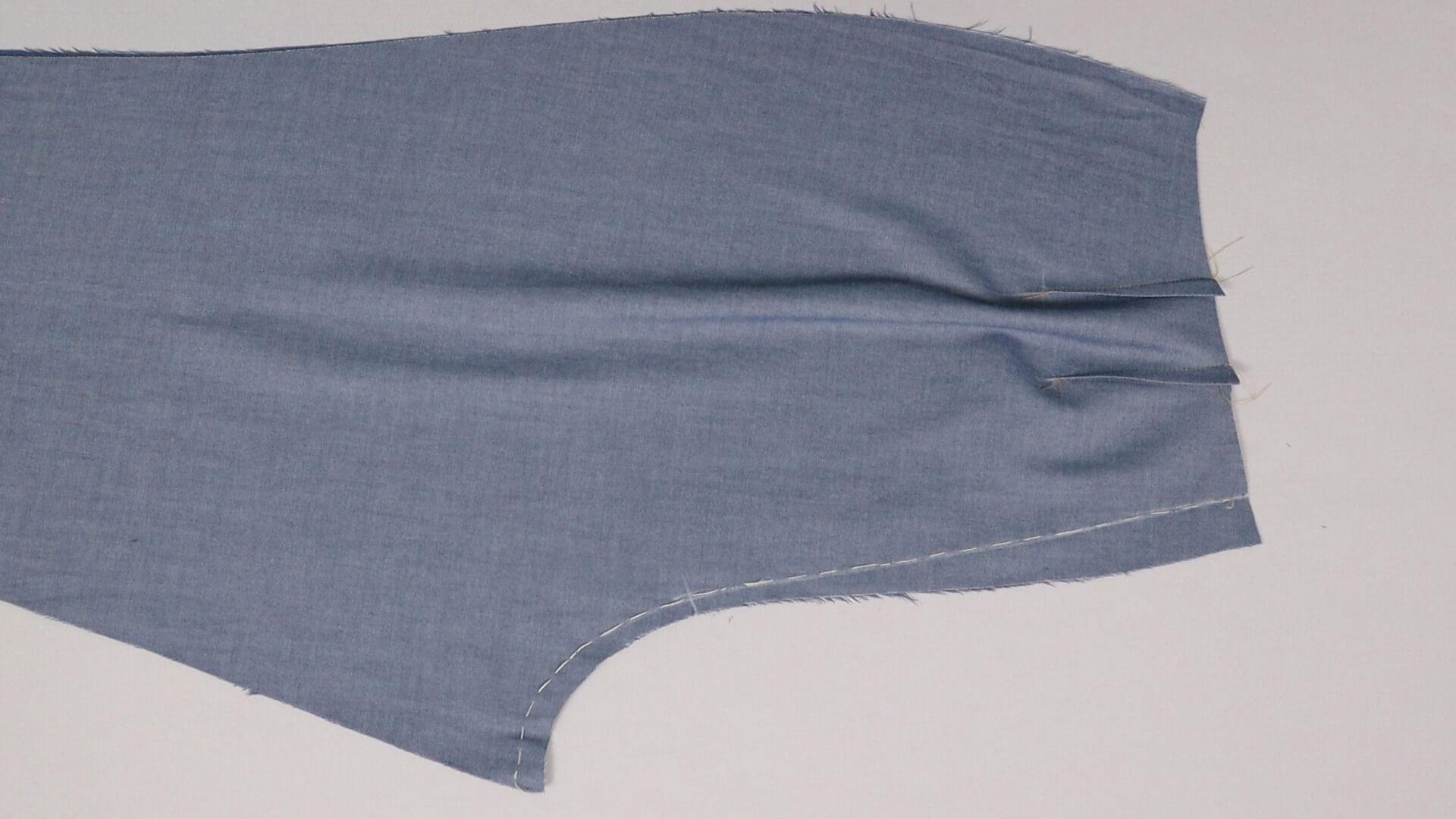
The back pieces are pinned in place and sewn together using a long machine stitch or a basting stitch.
3. Close the front crotch seam
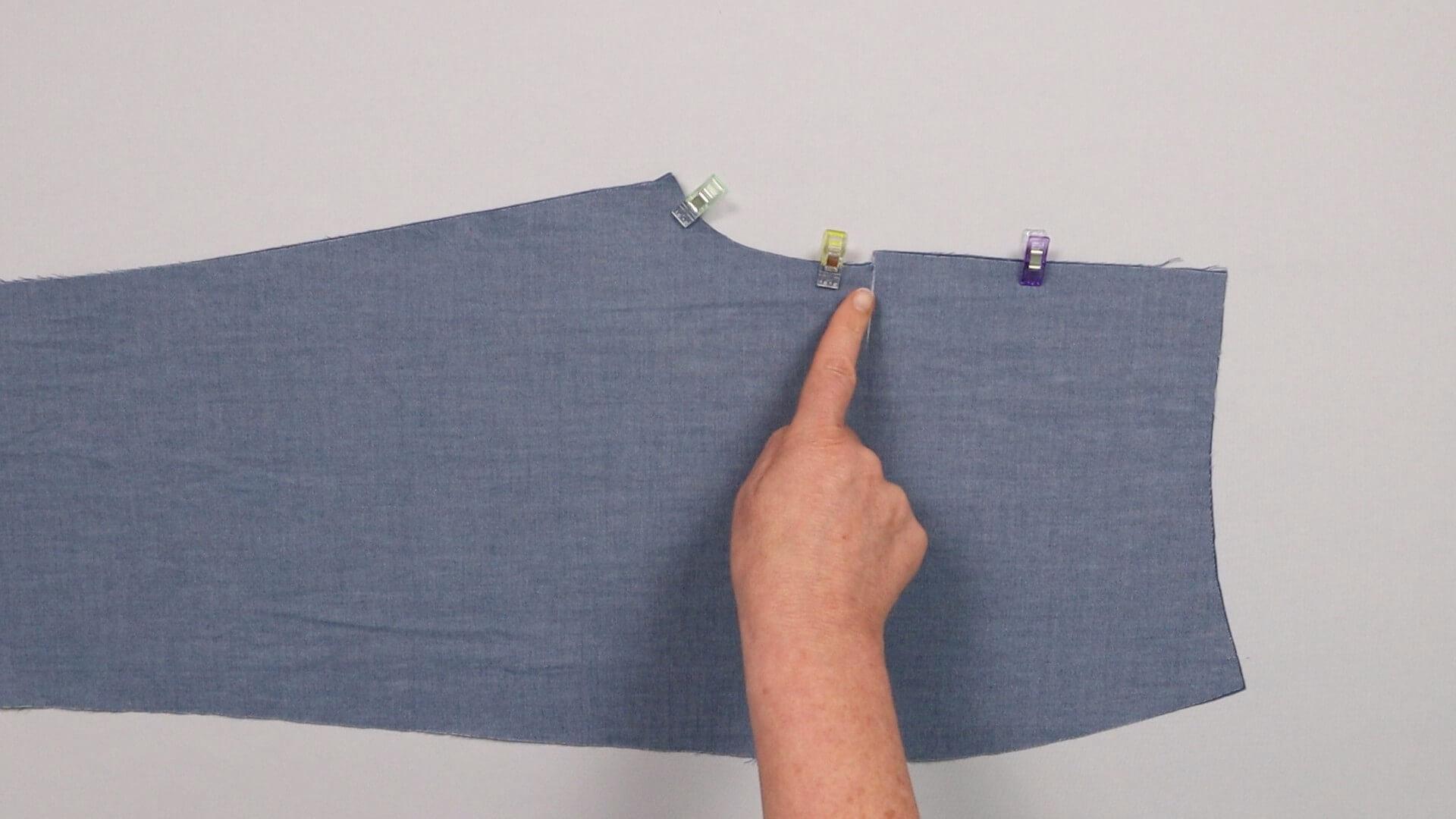
I place the front pieces right sides together, pin them in place at the short crotch seam and sew the section up to the fly.
4. Mark the pocket position on the back trousers
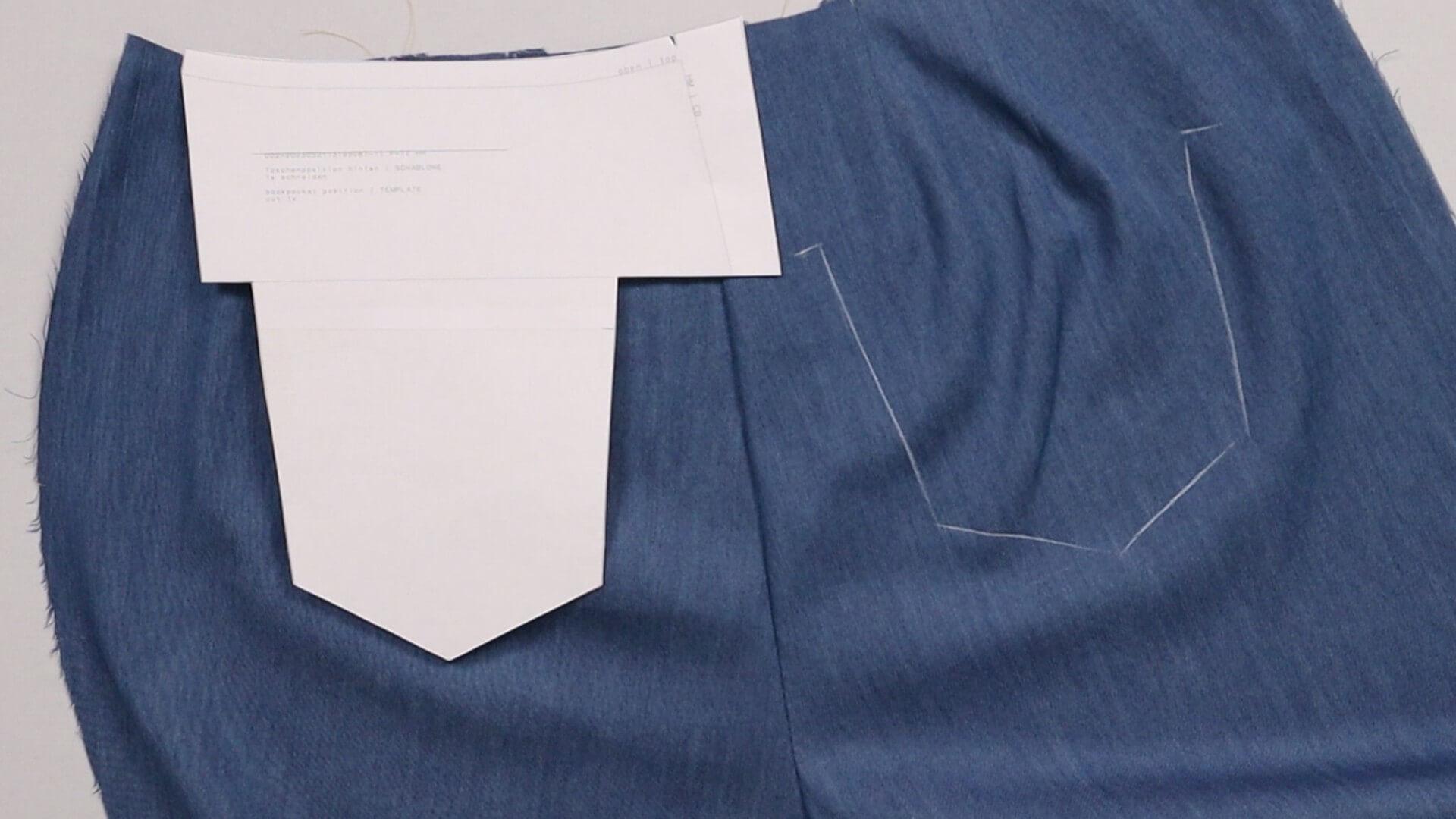
If you have opted for trousers with back pockets, I recommend marking the pocket position on the back of the trousers. The position is a question of personal preference and can be changed after fitting, if you don’t like it.
I lay the back pieces in front of me, right side of fabric facing upwards and align the template with the center back and the top edge of the back trousers.
5. Close the leg seams for fitting
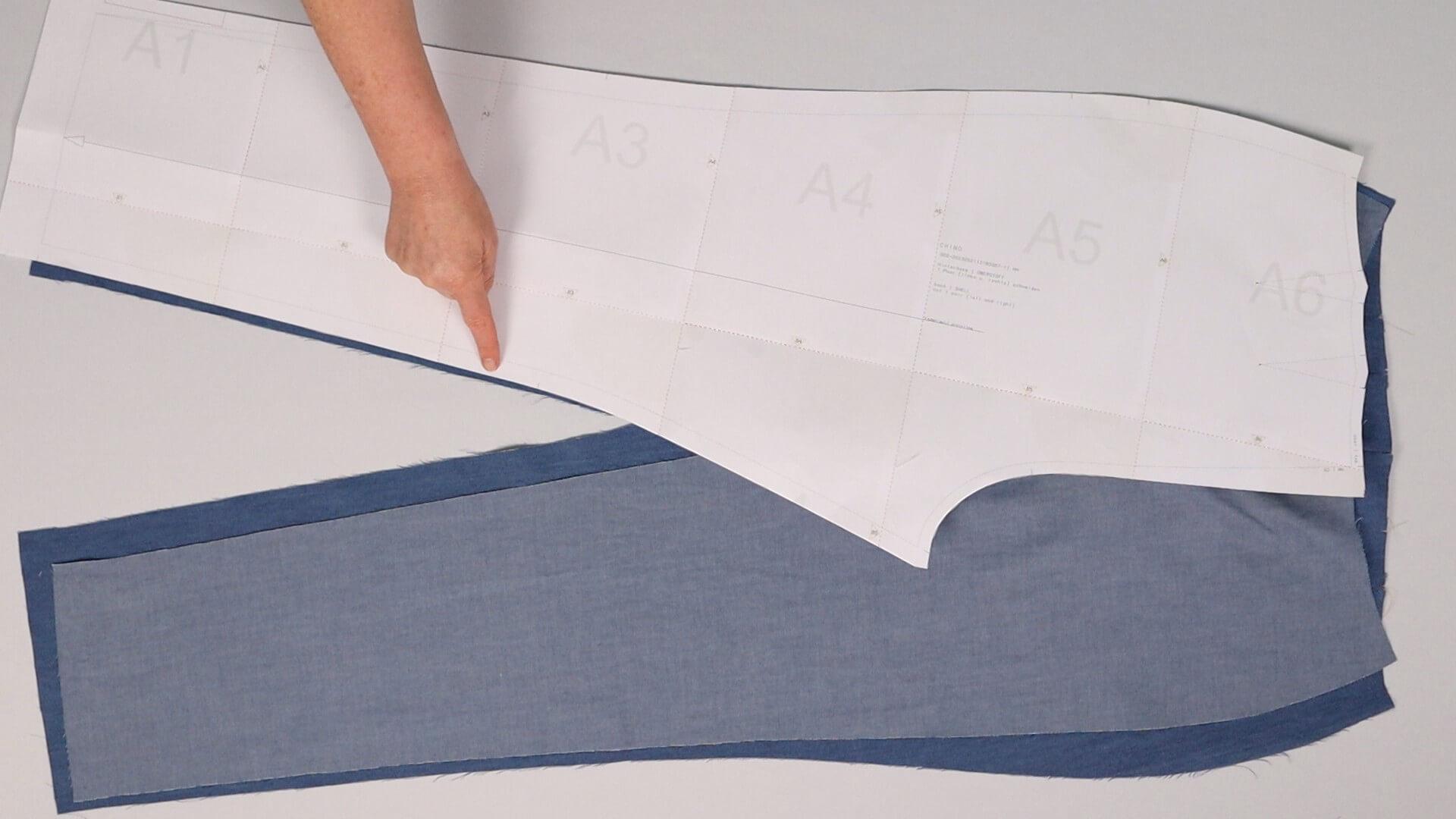
Next, I close the leg seams. Note how wide the seam allowances should be. You can measure this in the pattern or recognize it by the distance between the notches at the beginning or end of the seams. If there are no notches, the standard seam allowance of 10 mm applies.
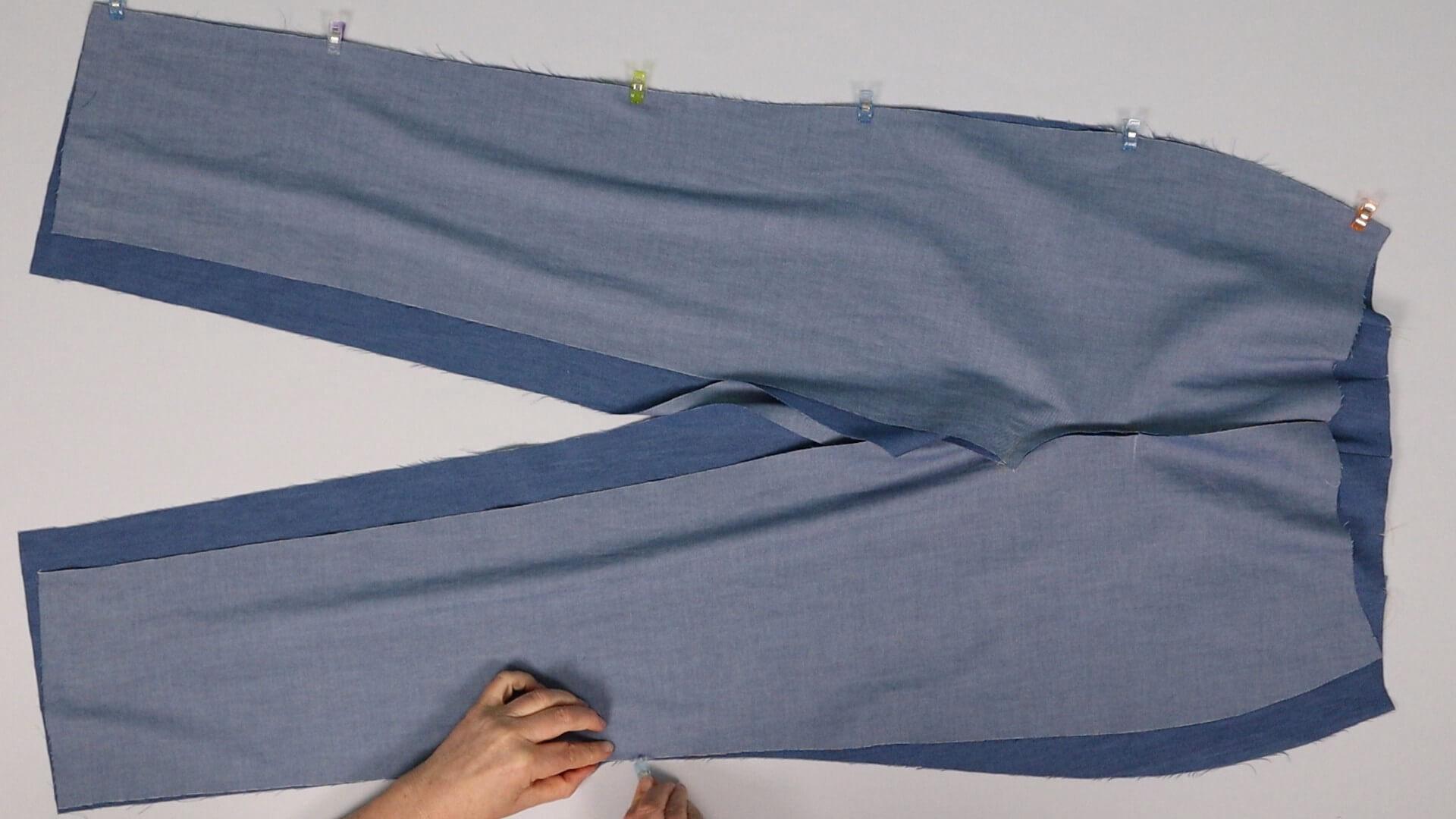
I place the front trousers right sides together onto the back trousers and pin them in place at the outer leg seams. I make sure the notches meet.
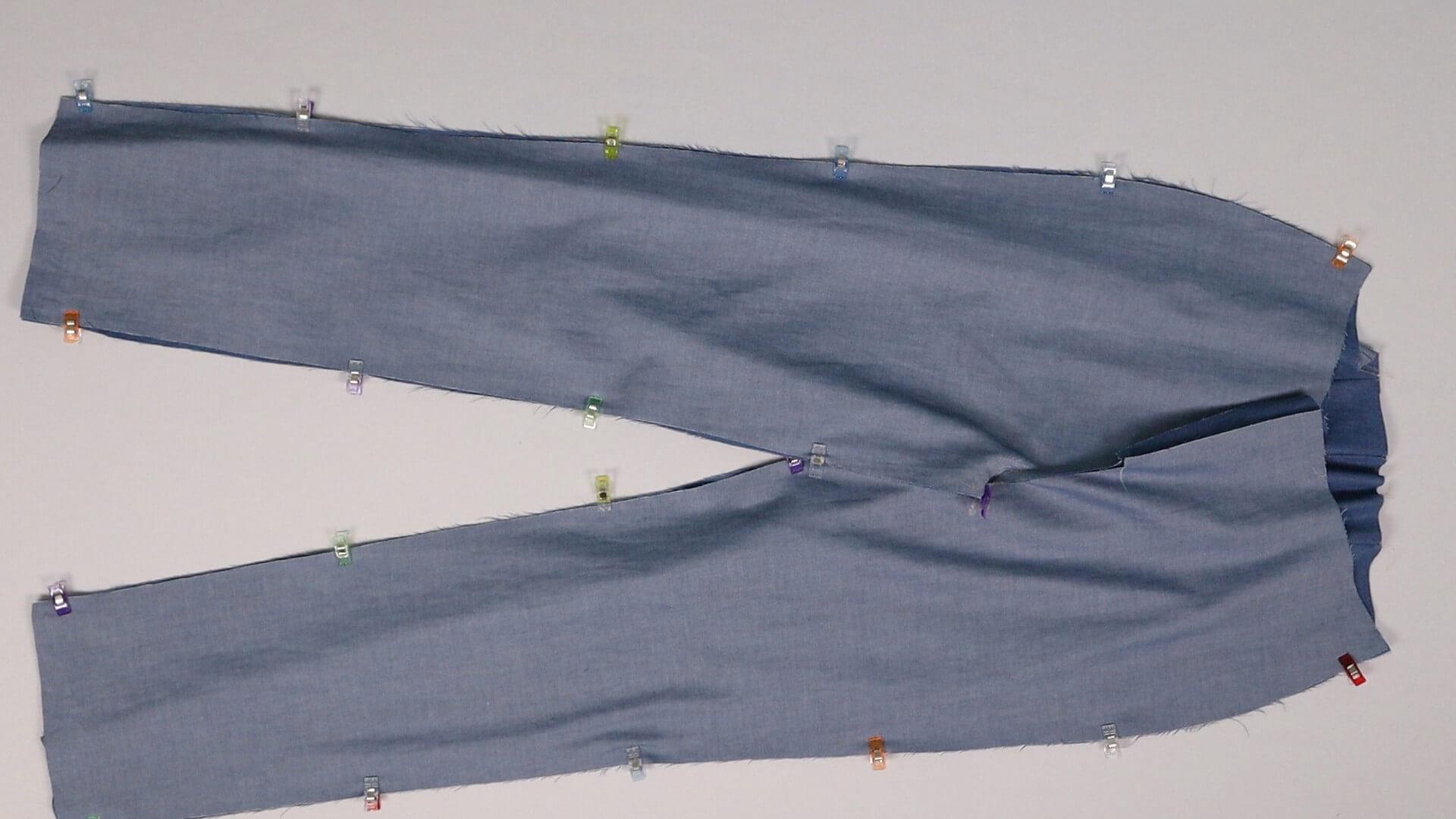
I then pin the inseam in place and make sure the seat seam and the short inseam of the front trousers meet exactly. From this crossing point – also known as the crotch seam – to the knee, you need to stretch the back trousers slightly to the length of the front trousers. This difference is included in the pattern for a better fit.
The leg seams are now also joined with a long machine stitch or a basting seam.
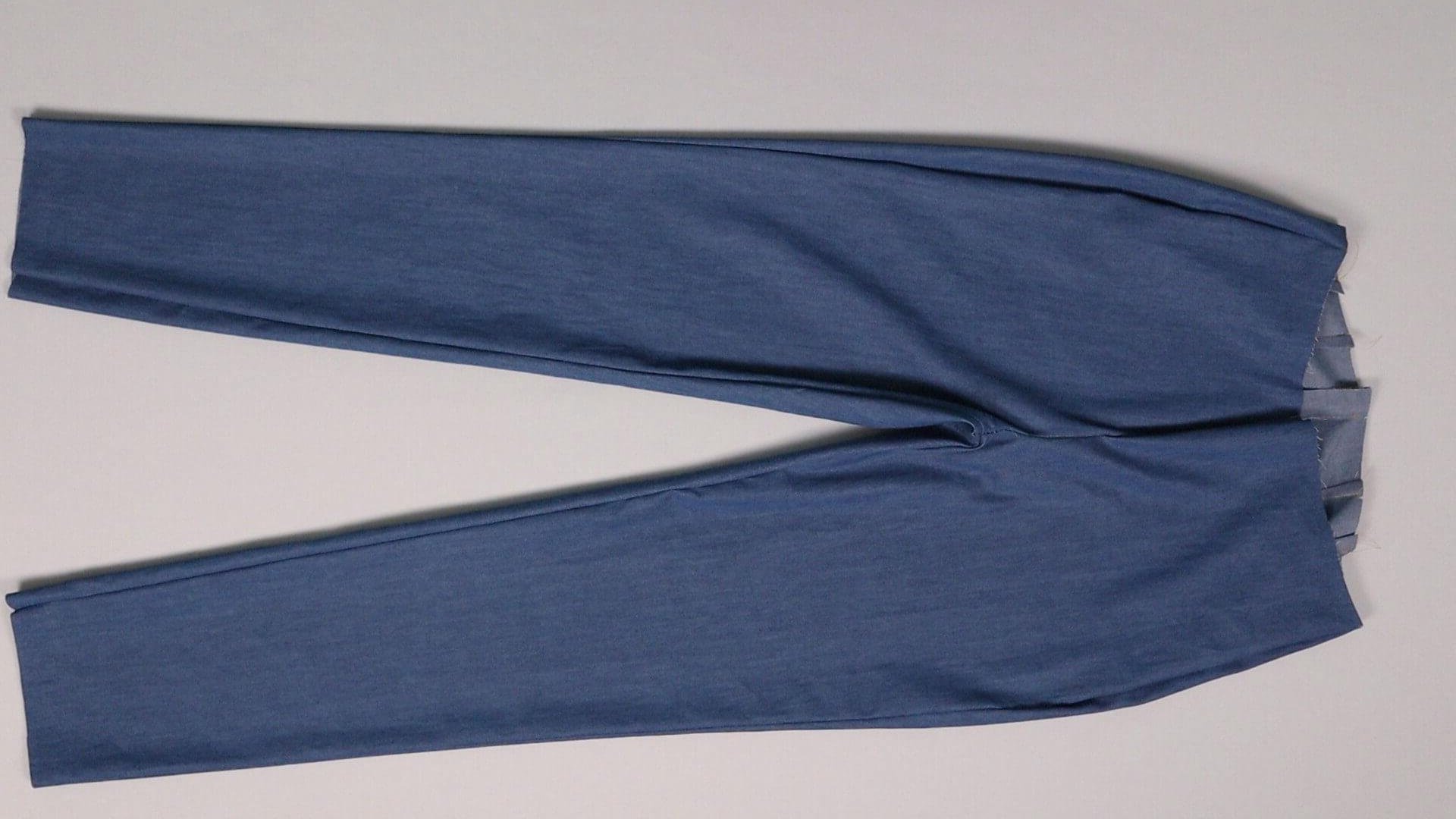
Now you can turn the trousers right side out.
6. Pleat option
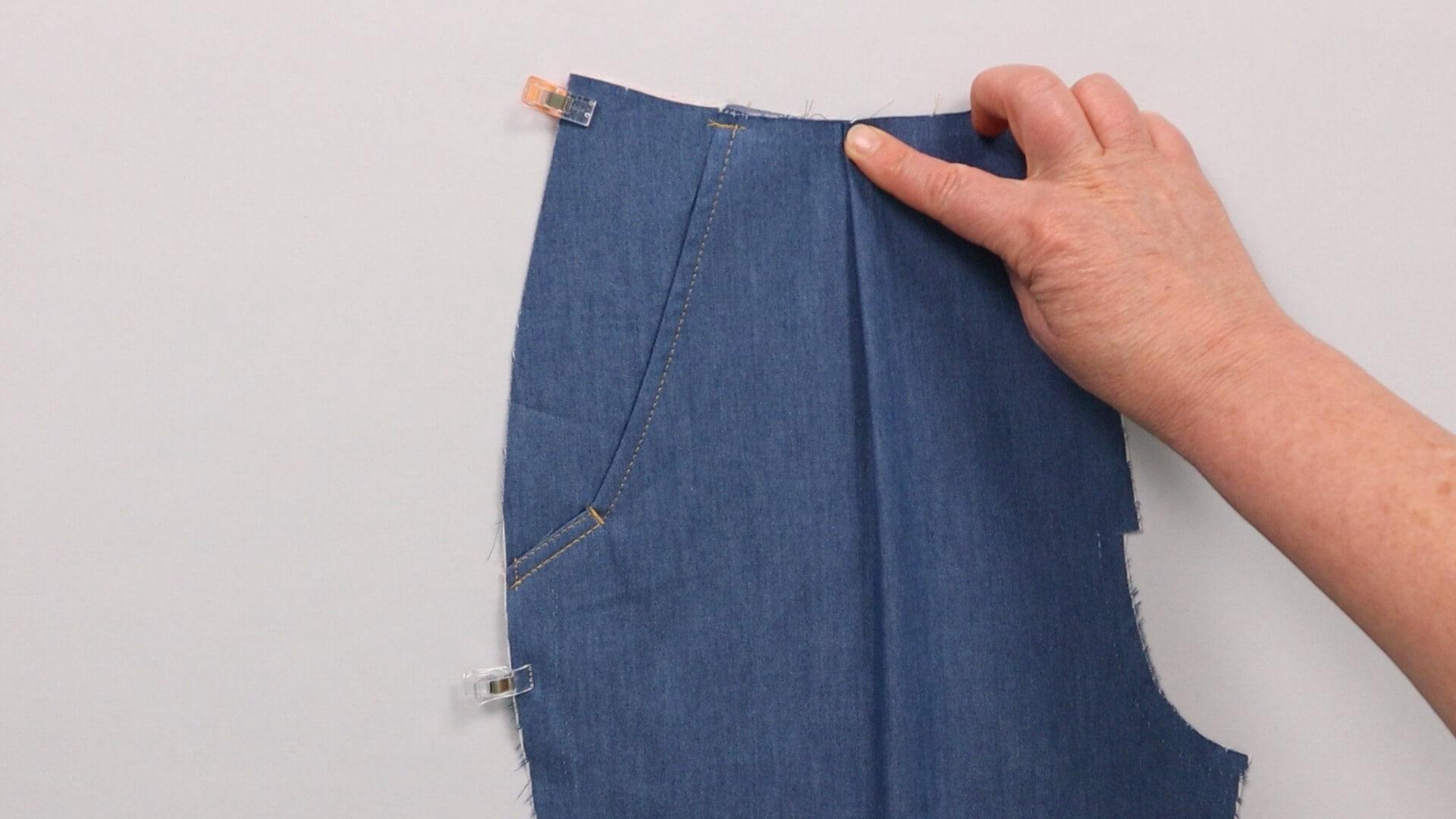
If you have chosen a trouser shape with a pleat, you should now fold it and secure it with a few stitches.
7. Prepare the waistband for fitting
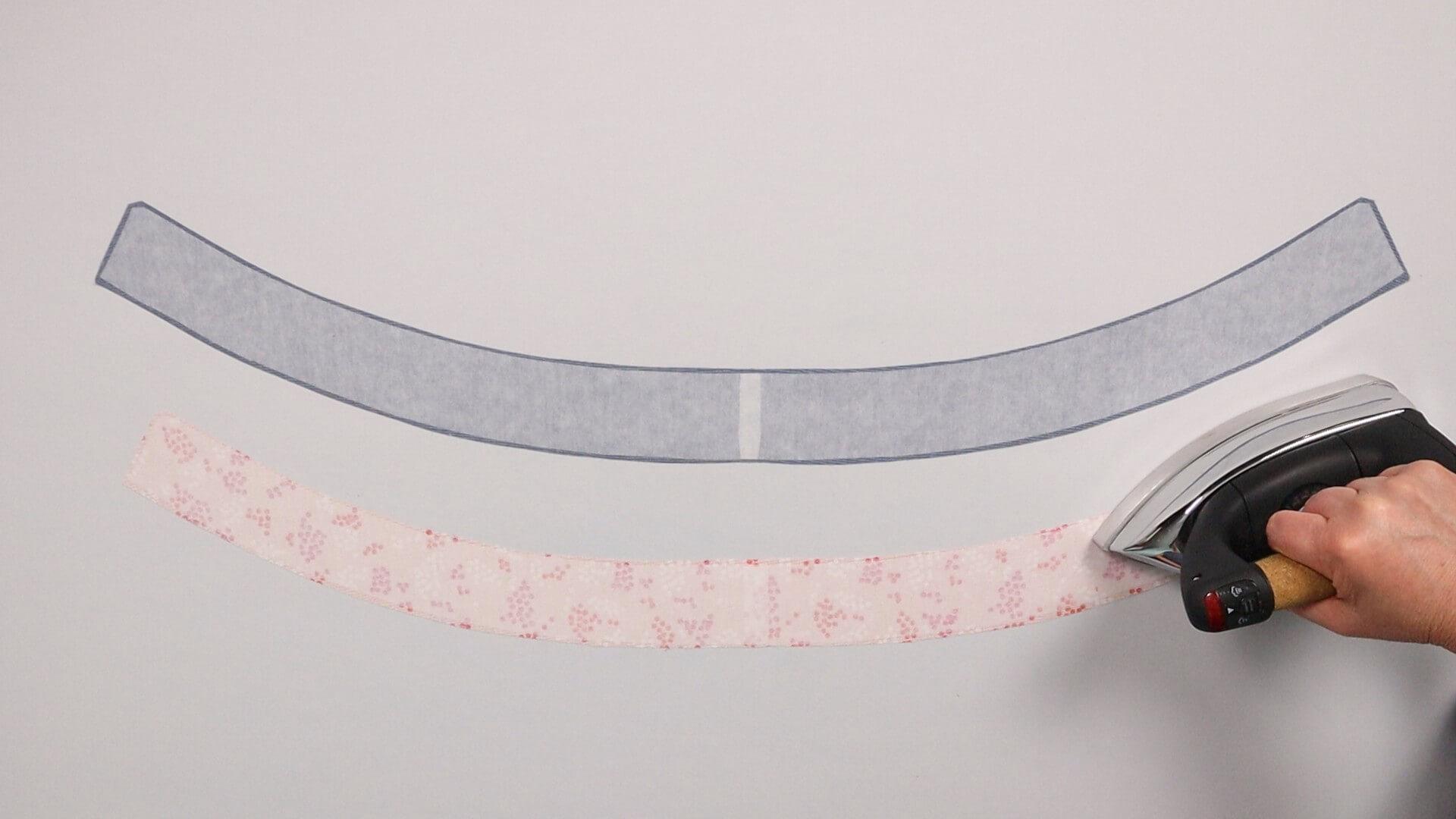
Before I attach the waistband, I prepare it. First I iron the interfacing. If you are using a sturdy fabric, it is not absolutely necessary to fix the inner waistband as well. However, this is a matter of personal preference and depends on whether you prefer the waistband to be stable or softer.
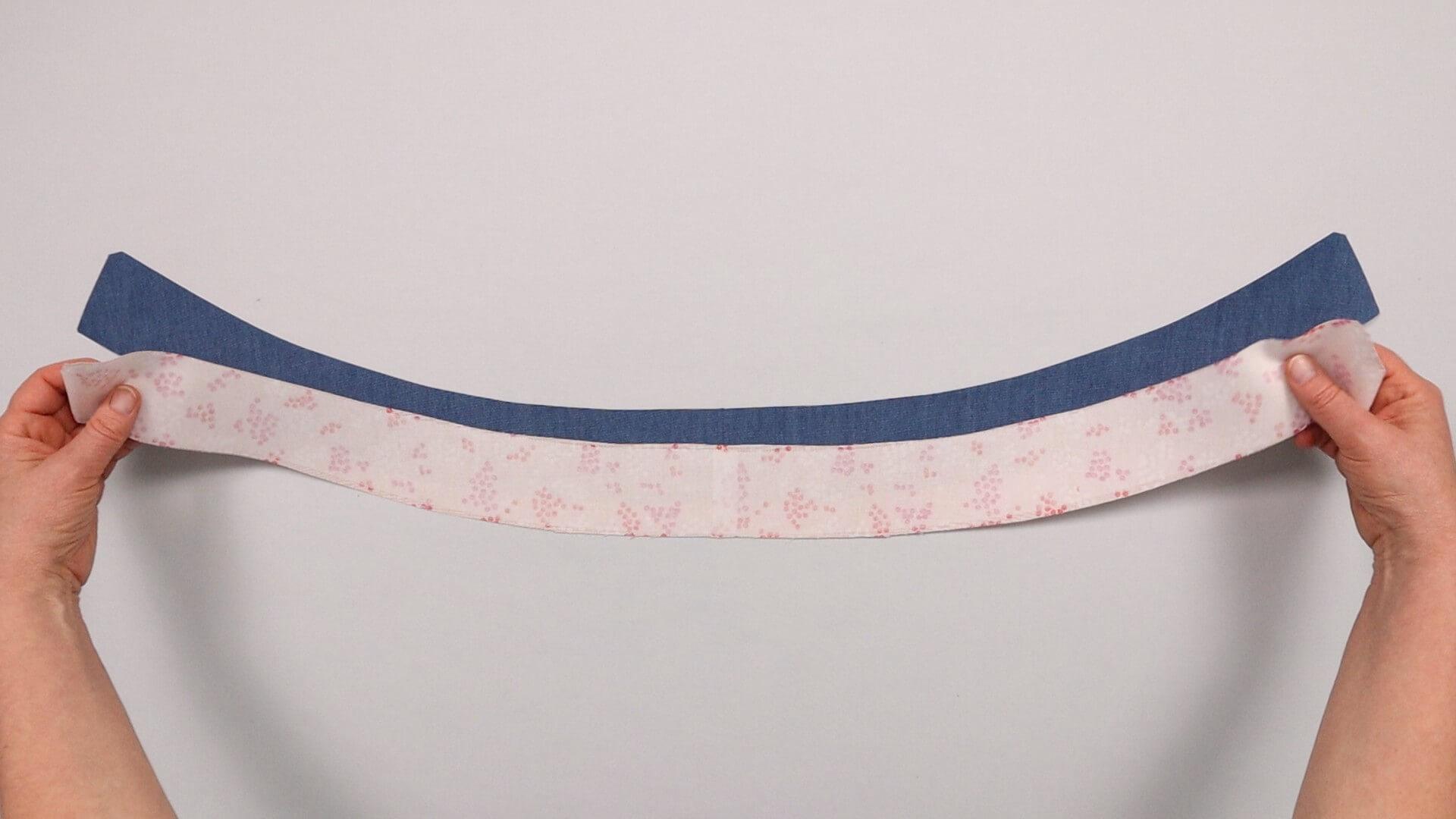
I now place the strips right sides together and pin them in place at the top edge.
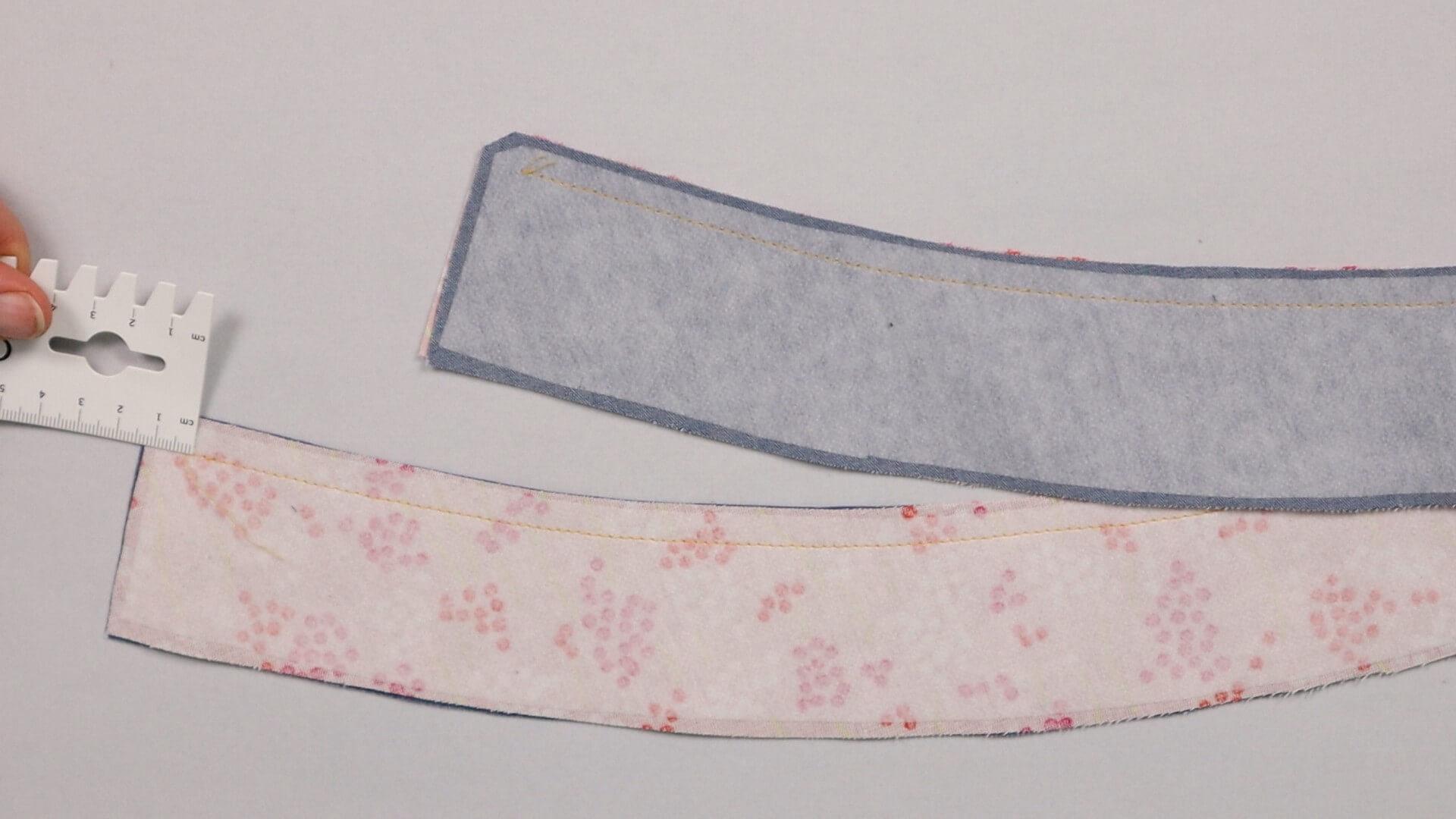
Since this seam is no longer unraveled, I sew together the top edge at 1 cm seam allowance with a normal stitch length. I start and end approx. 1.5 cm before the short edges. The beginning and end are not backstitched, as a short piece has to be undone again later, depending on how the corners are worked.
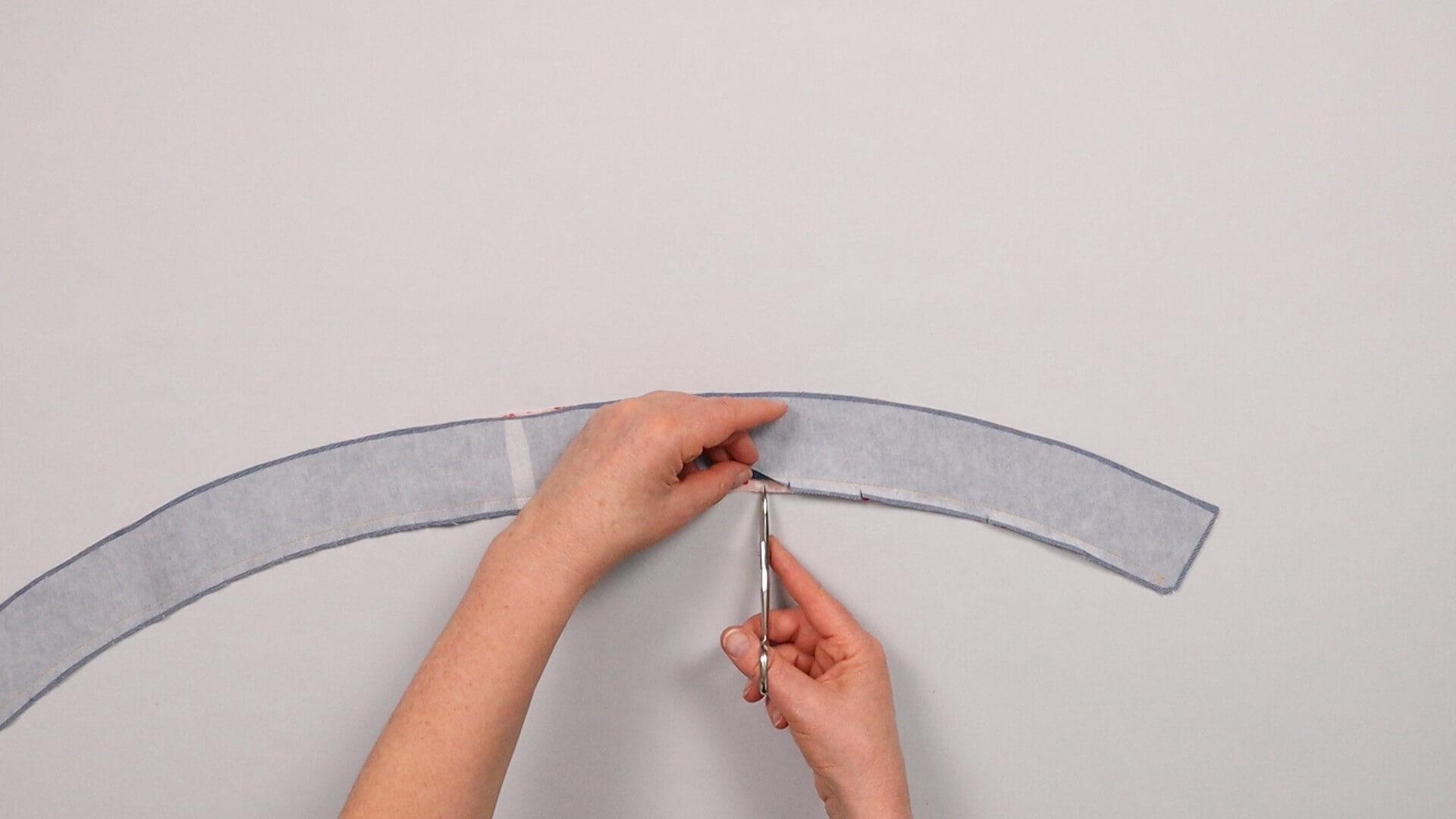
With a shaped waistband, I cut the seam allowance at the top edge of the waistband several times to release the tension when turning the waistband right side out. To minimize the visibility of the incisions, I offset the incisions at the top and bottom layer.
You can skip this step if you have opted for a straight waistband.
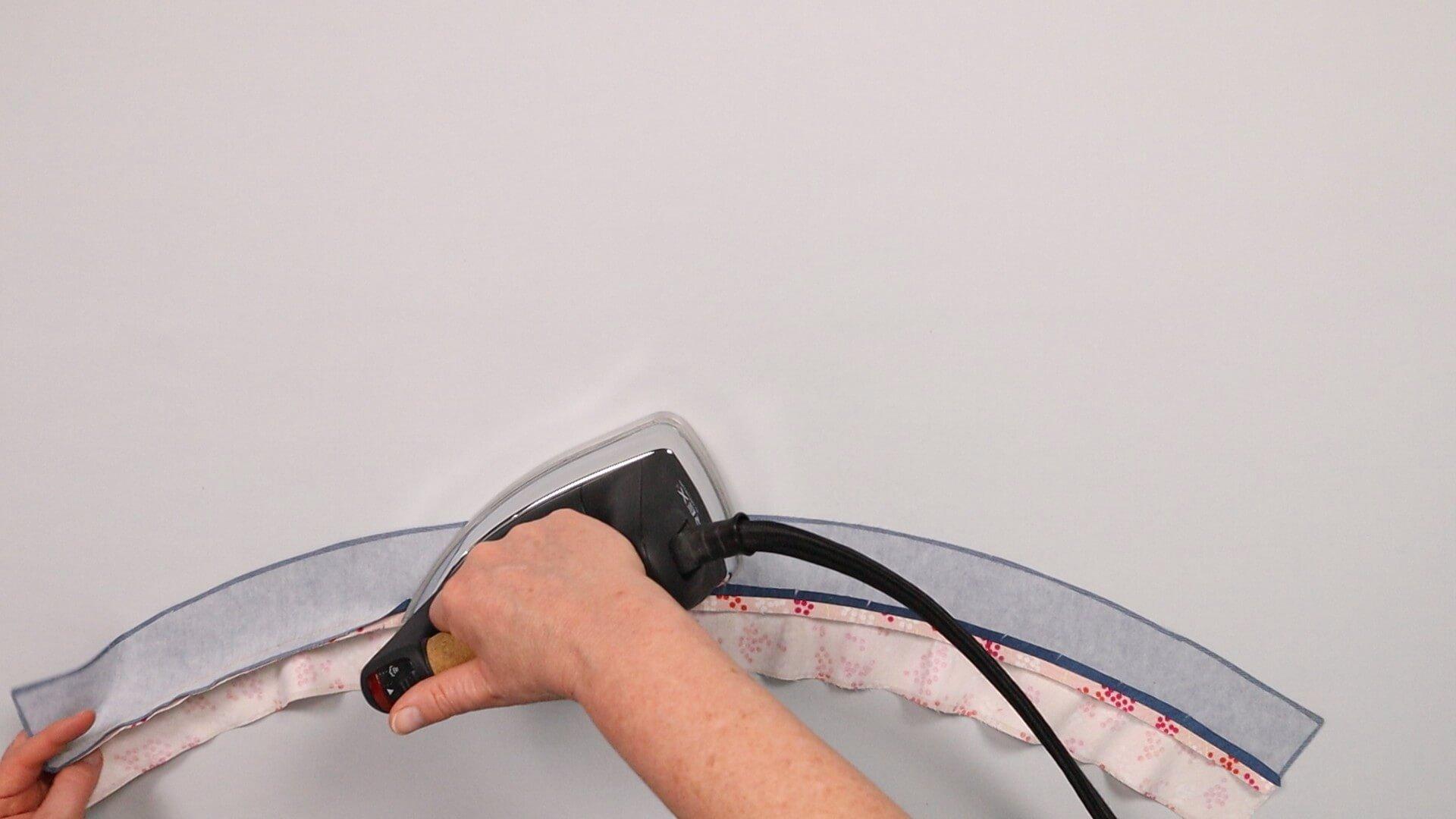
Next, I press the seam allowances open at the top edge of the waistband.
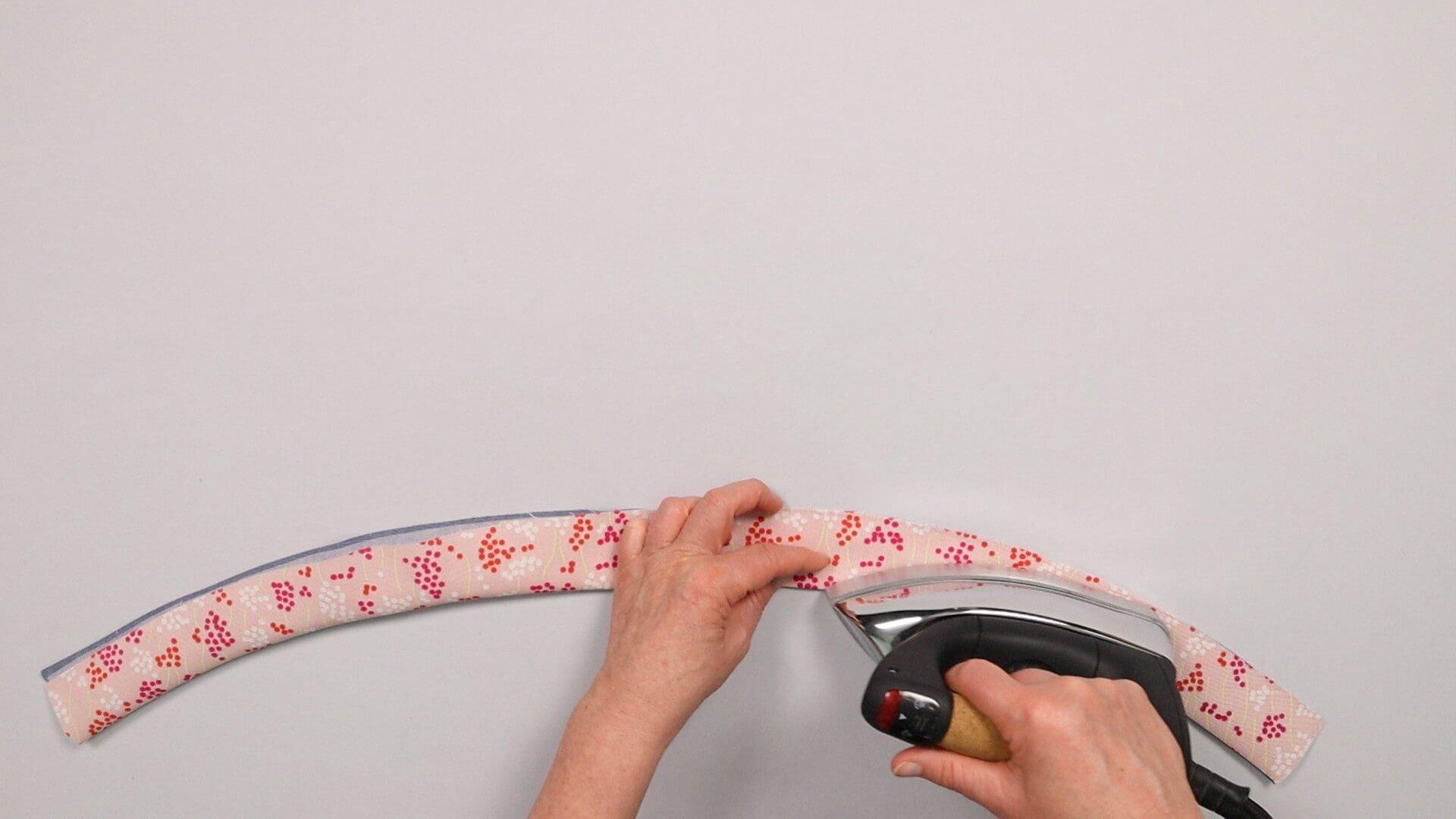
Then I turn the waistband, wrong sides facing, and press the seam flat from the inside. I make sure that it lies slightly toward the insiede of the wasitband so it is not visible from the outside.
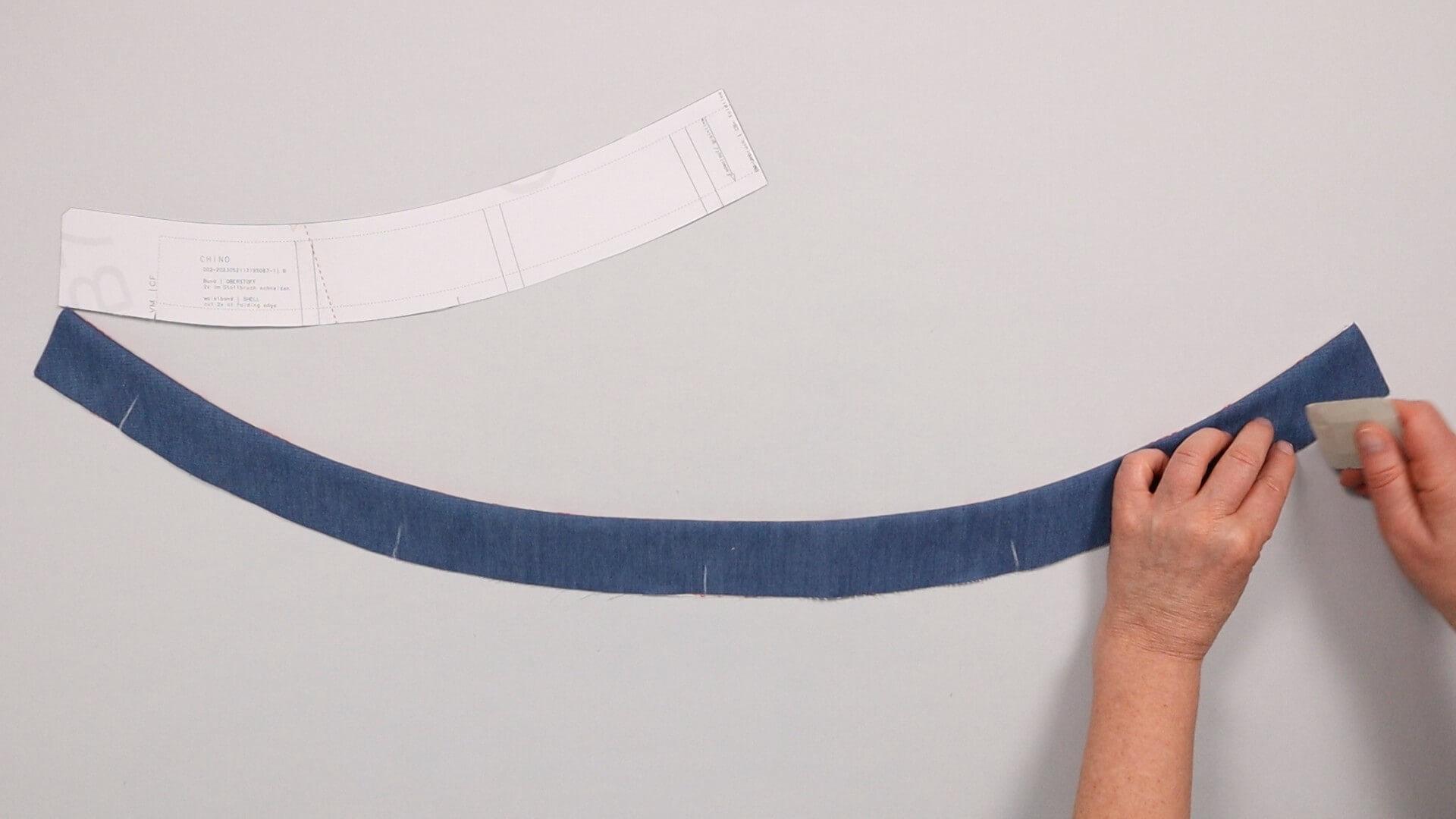
I transfer the notches for the center back, the side seam and the center front to the outside of the waistband if I haven’t already done when cutting.
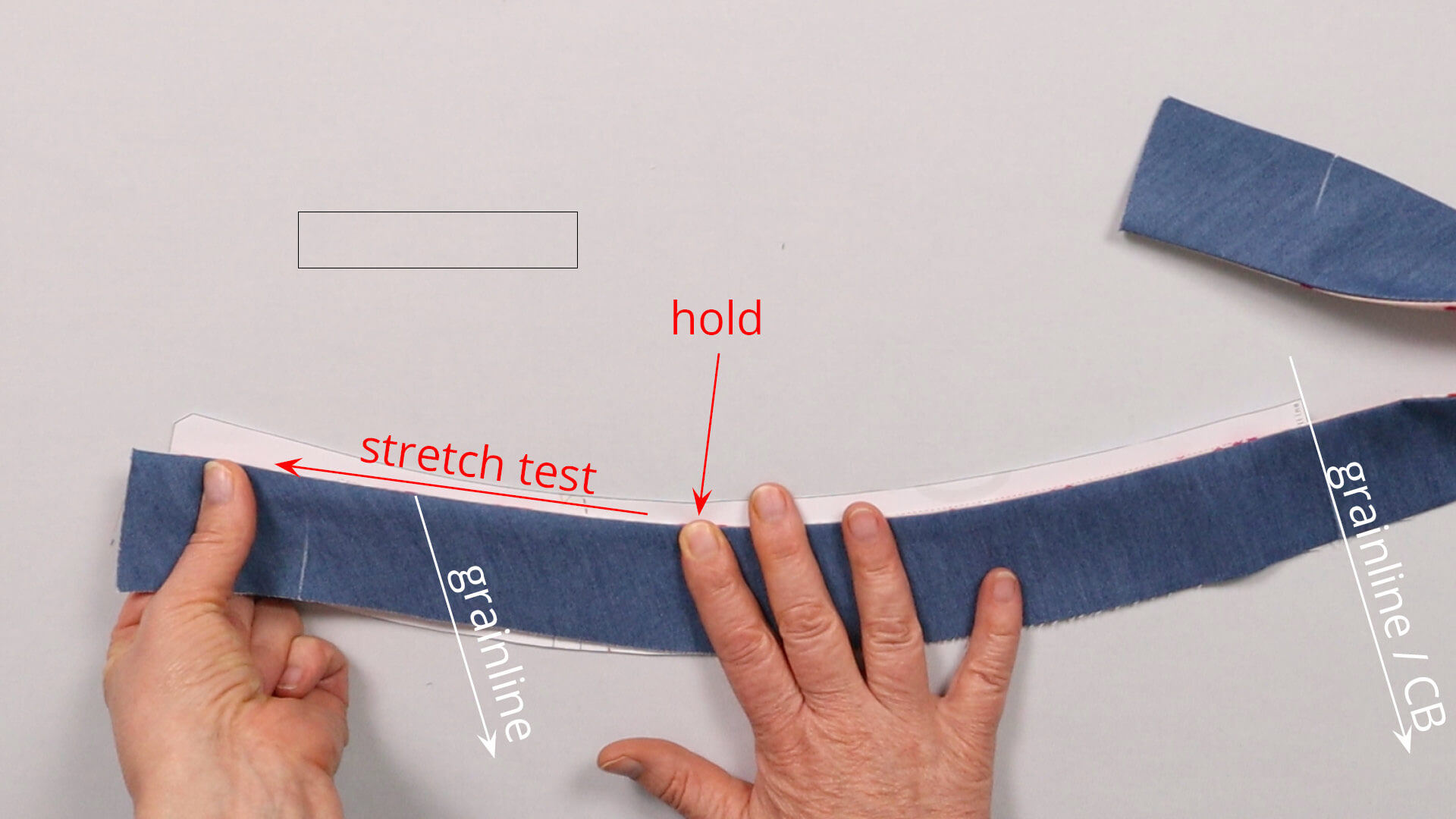
Now it’s a good point to check whether the waistband length still matches the pattern. Possibly it has been altered by sewing or ironing. I also check whether the seam in the front area of the shaped waistband, where the fabric lies in the diagonal grainline, is still stretchy.
8. Pin the waistband on the trousers
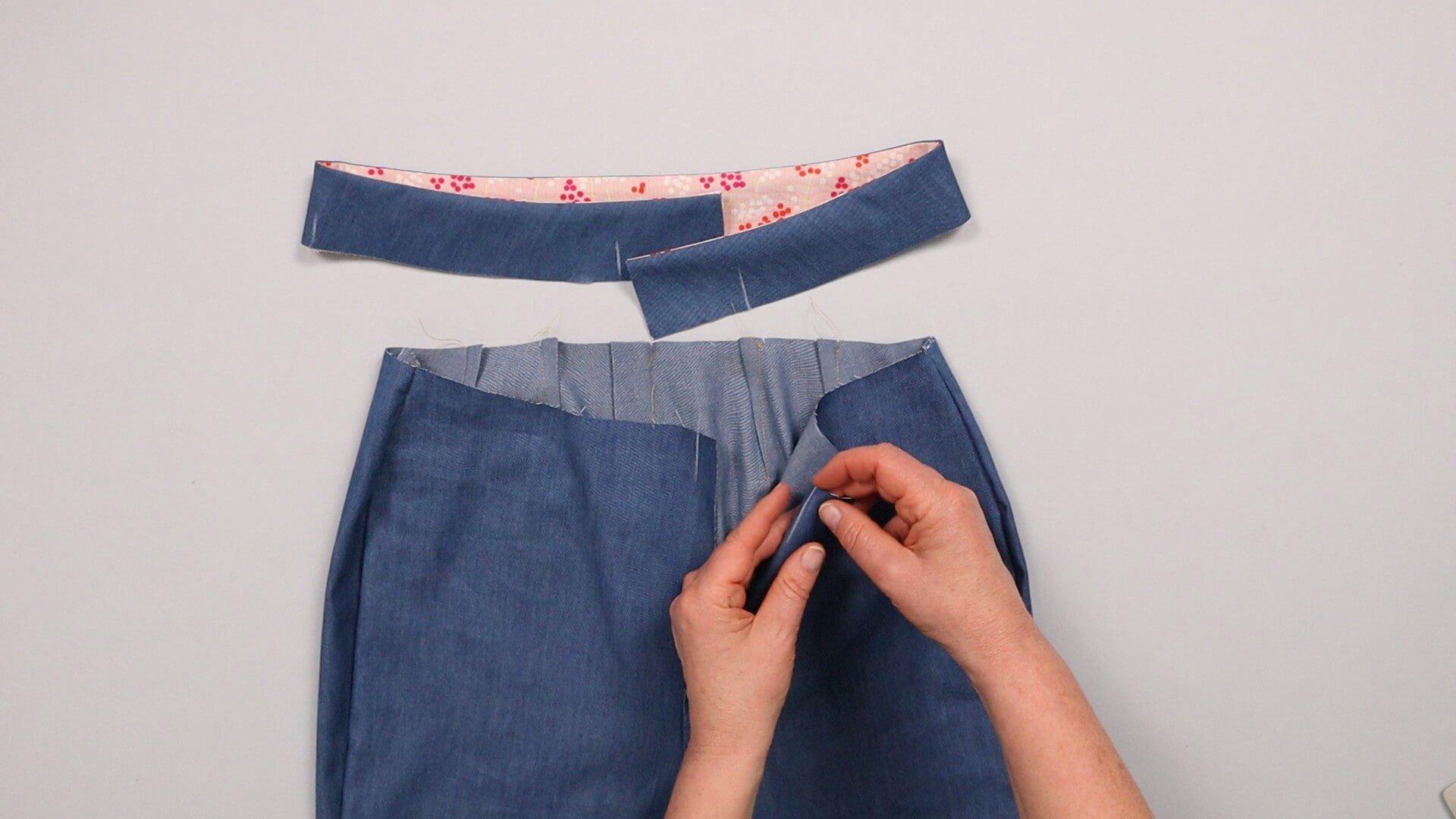
I also mark the center front on the trousers and fold the left front piece inwards at the marking.
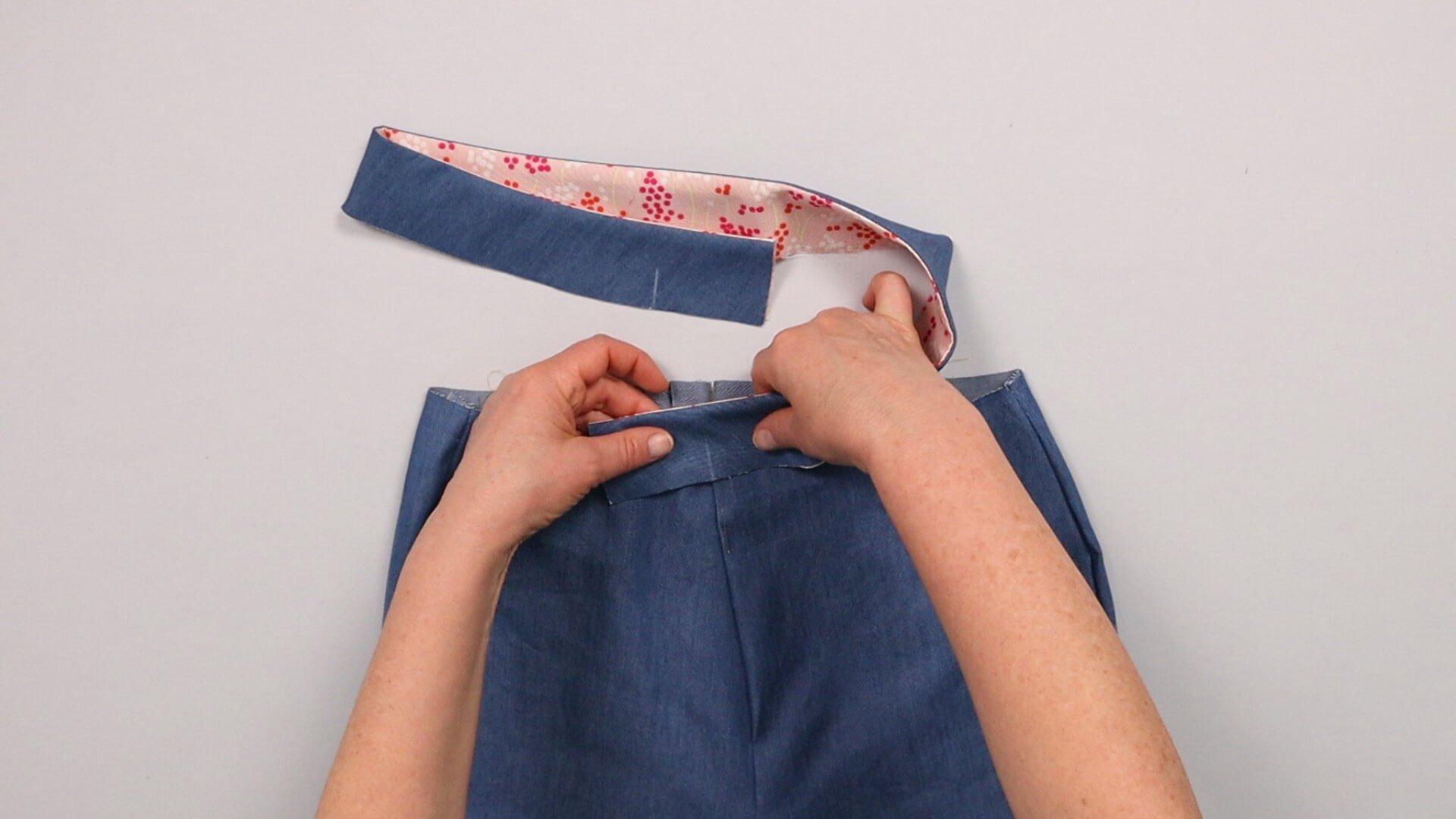
Now I pin the waistband on the trousers. Make sure that all notches meet.
Caution: The waistband is too long on the side where it overlaps at the front. Don’t let this confuse you – this will be adjusted when the waistband is sewn on later.
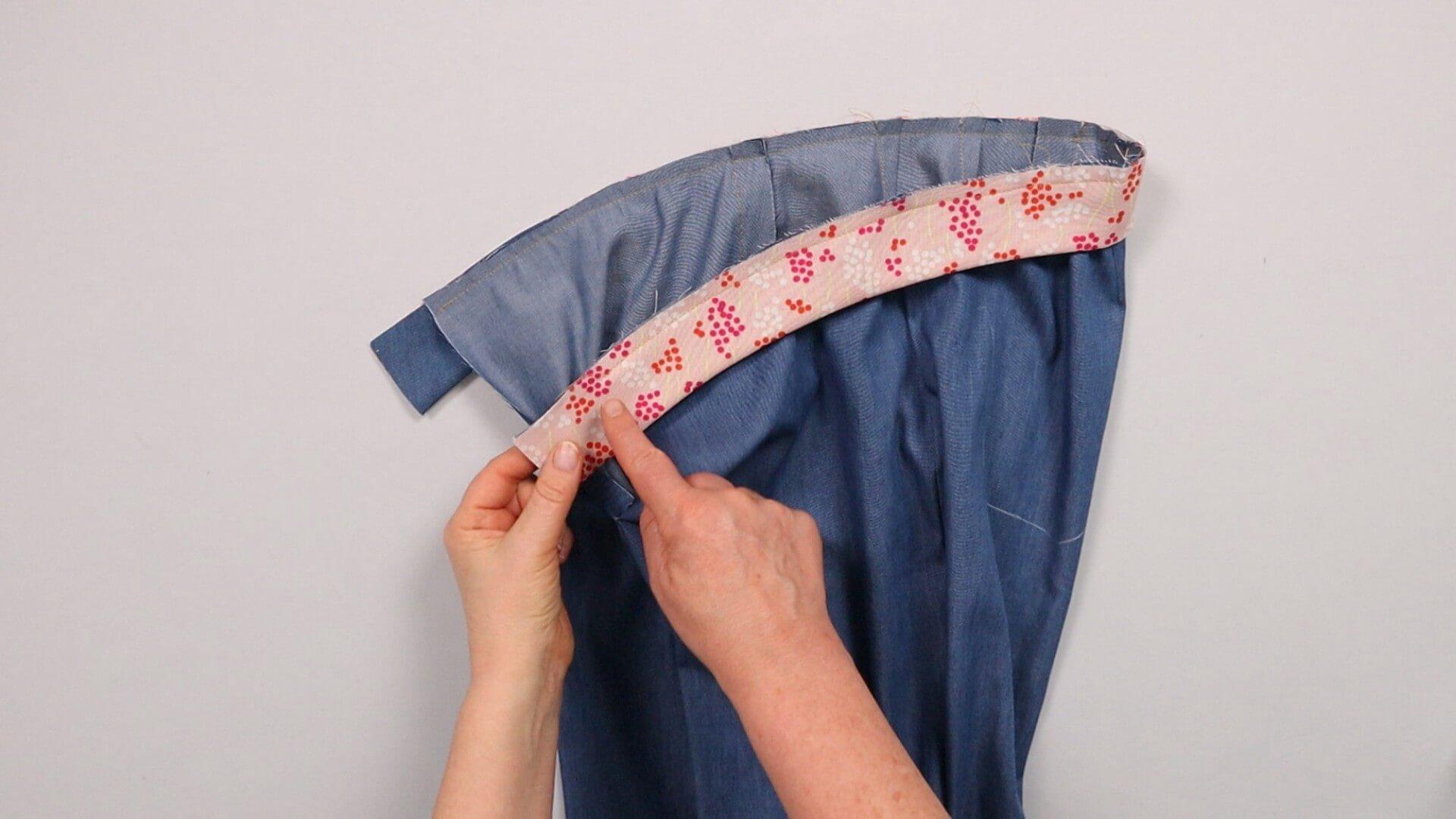
Now I sew on the waistband. Again I use a long machine or hand basting stitch.
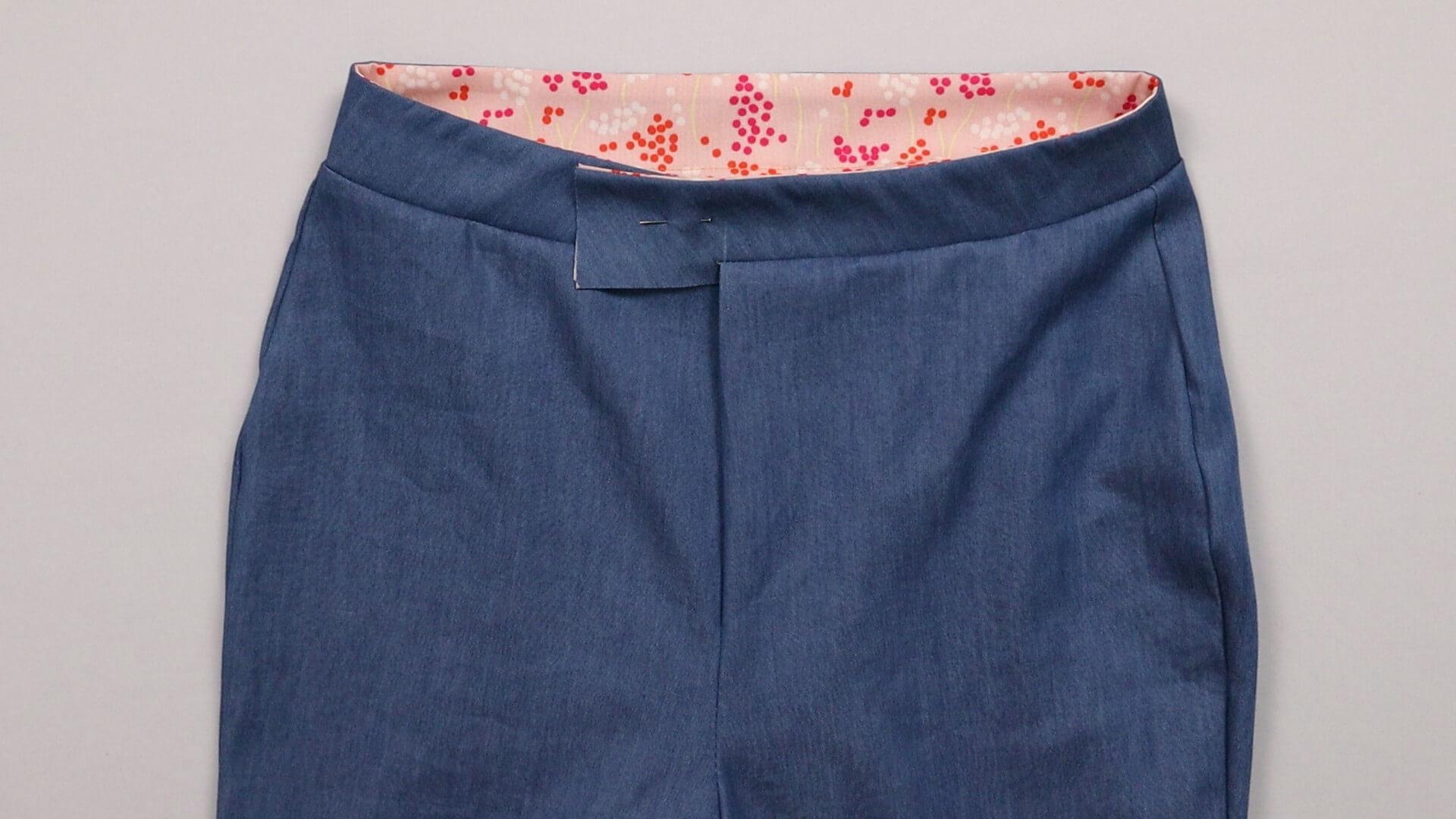
This is what your trousers look like when they are ready tfor fitting.
9. Fitting and checking measurements
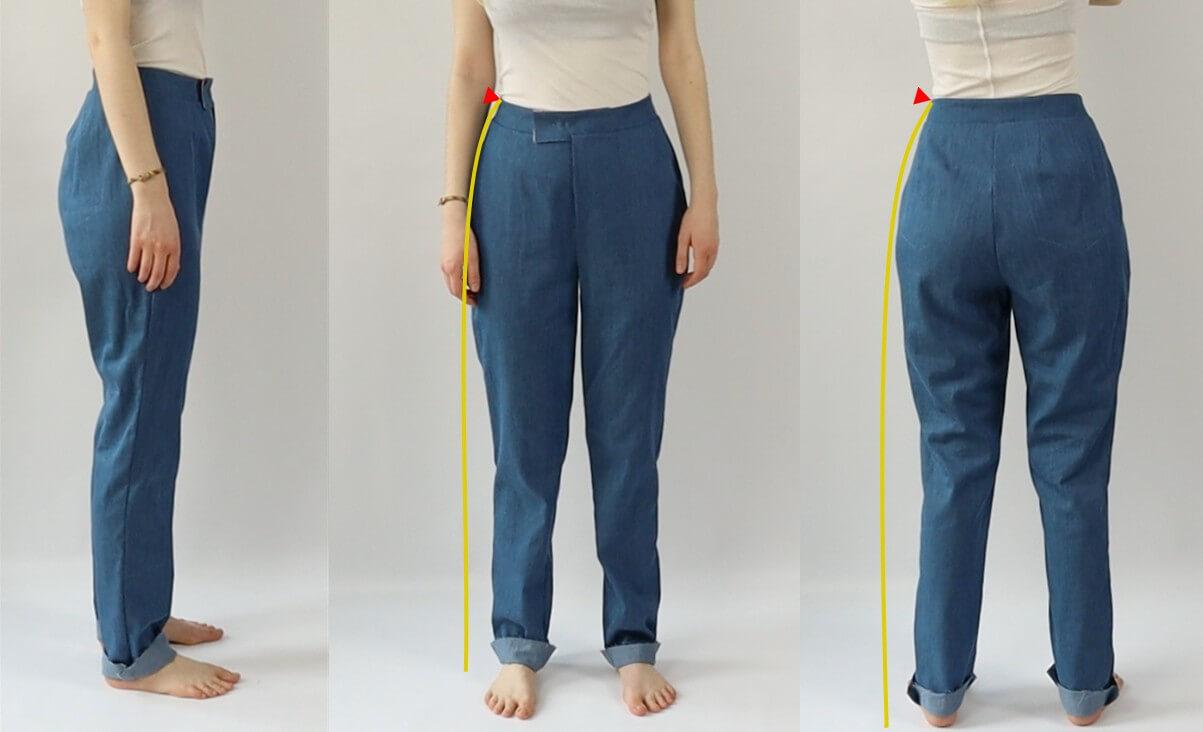
Now the time has come – you can try on your trousers for the first time!
Here are a few tips on what you should bear in mind when trying them on:
- To get an impression of how the trousers fit, I recommend taking photos that include at least the three perspectives in the picture above. You should take the photos as straight as possible – i.e. not at an angle from above or below.
- Make sure that the waistband is at the right hight. As there is still no button to close the trousers properly, they can easily be pulled up a little too high or too low. To check this, you can measure the side length from the floor to the top edge of the waistband (see marking) and compare it with the side length you entered in the configurator.
- If the waistband sits at the right hight but is still too tight or too wide, compare the measurement you entered when configuring with the circumference measurement at the point where your waistband sits now.
- If the trousers seem a little too wide at the hips, remember that there will be pockets, which – depending on the thickness of the fabric – will also need a little space. It is best to try the trousers on again before sewing the waistband on the inside of the trousers.
- The tighter the fit you have chosen and the less stretchy your fabric is, the more likely it is that the trousers will wrinkle at the back of the legs. This is because the trousers have an extra length at the back which you need to sit down comfortably.
- Wrinkles sometimes look worse in photos than they really are. Be sure to take another look in the mirror to see what it really looks like.
If you still have problems with the fit, please send me an e-mail with pictures of how the trousers look when worn (see above) and I’ll try to help. This works much better at this point than at a later date.
10. Cut the pocket opening on the front trousers to size
When you have finished fitting the trousers and have made all adjustments to the pattern, you need to cut the pocket openings on the front trousers. If you have opted for trousers that either have no front pockets or inseam pockets, welt pockets or patch pockets, this step is not necessary.
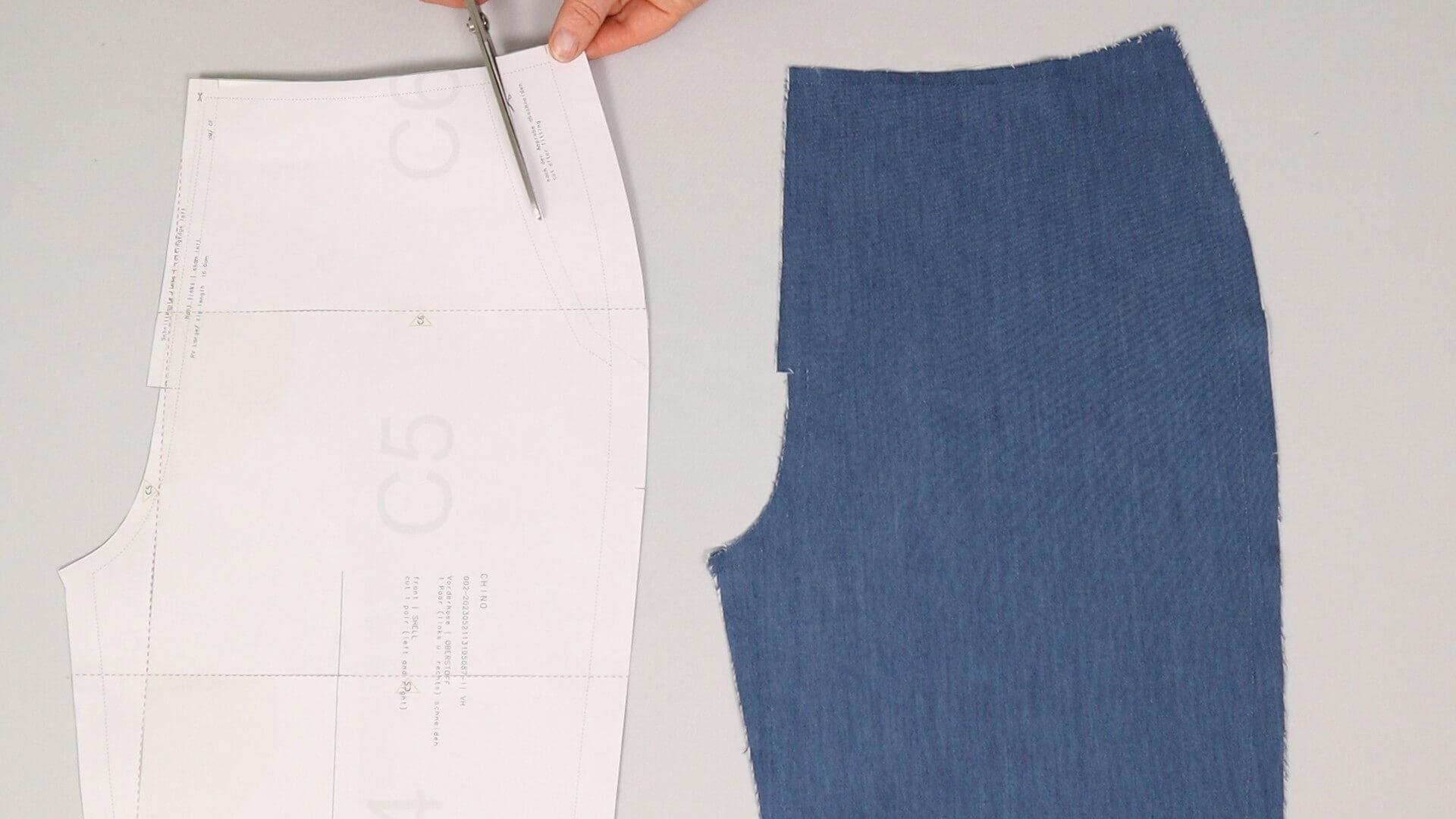
First cut this part away at the corresponding marking in the pattern.
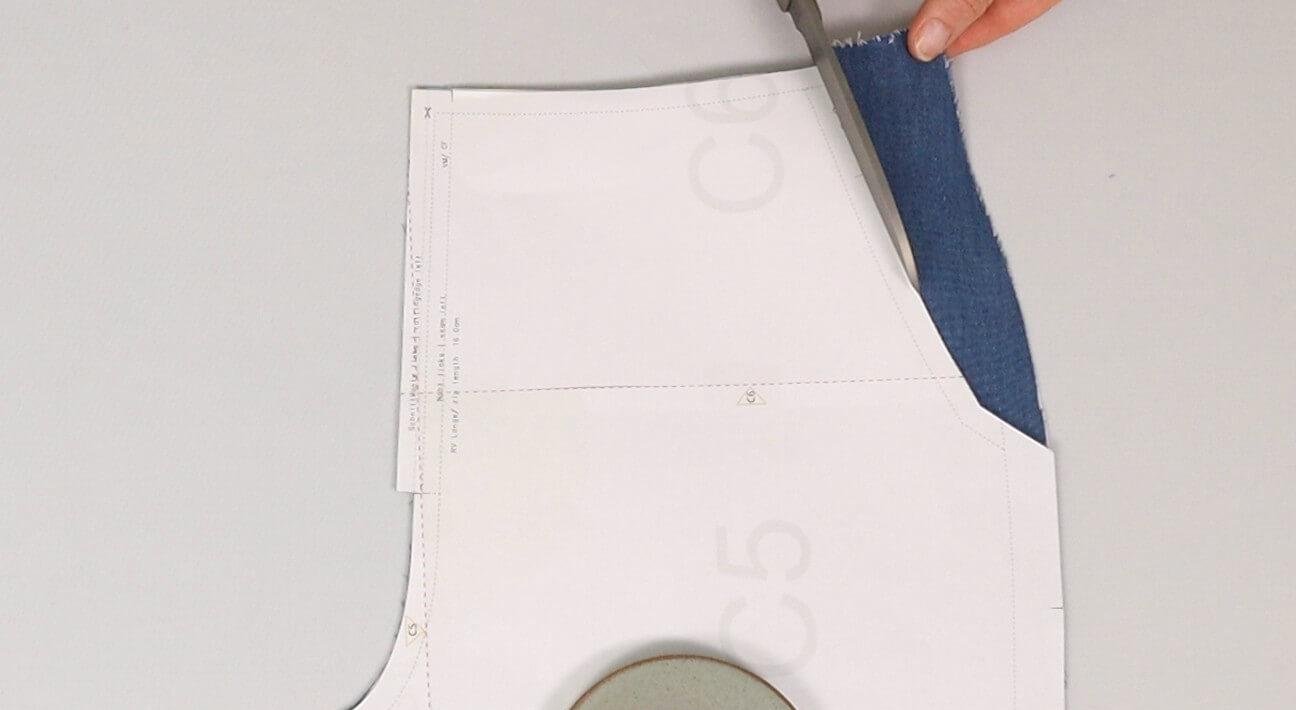
Then cut the two pattern pieces for the front trousers accordingly.
Here you will find the links to the next step. Select the link that belongs to the pocket shape you have chosen.
- Sew patch pockets on trousers #TH01
- Sew double welt pockets into trousers #TH02
- Sew welt pockets into trousers #TH03
If you don’t want pockets on the back trousers, continue here:
If you’re not quite ready yet and perhaps want to start at the beginning, you’ll find some links here:




